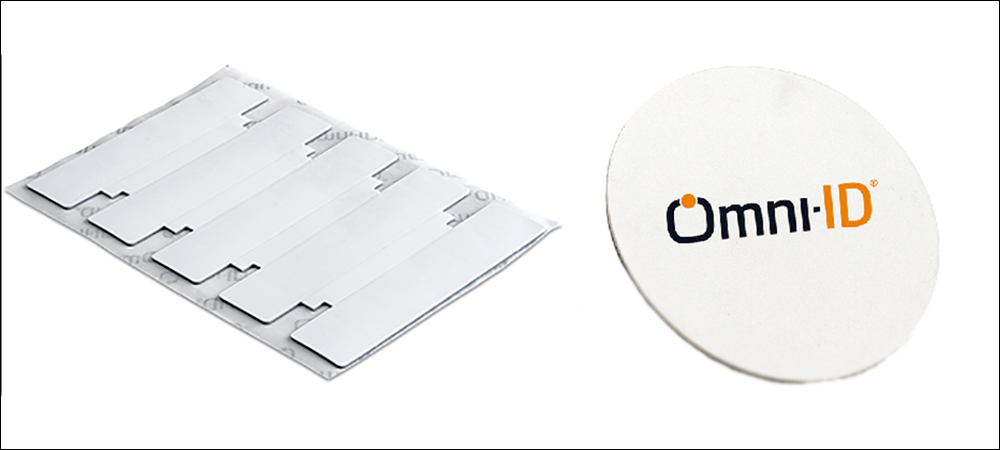- Leveraging the Axzon Magnus RFID Sensor Chip
- Broadening Wireless Sensing Options
- New Tags Provide Low Cost and Durability
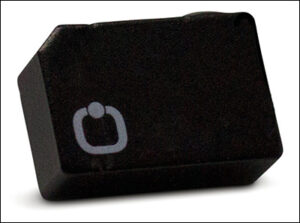
Sense Fit 500
Omni-ID, and Industrial Internet of Things (IIoT) tag maker, has extended its range of sensing devices to include five new tags built to monitor temperatures, detect the presence of liquids and measure those liquids’ volume. Since the release of its passive Sense products, several companies have been testing the tags for use cases that include managing conditions around everything from electric car batteries to cultivating cannabidiol plants for the pharmaceutical industry. The products include printable on-metal, off-metal and ceramic tags for multiple sectors, designed to monitor temperature and humidity levels.
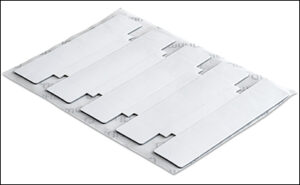
Sense IQ550P
In 2019, Omni-ID released its first Sense products, which were IoT-enabled active tags that could detect conditions and transmit details via low-power wide-area network (LPWAN) transmission—in the form of LoRaWAN technology—and Bluetooth Low Energy (BLE) transmissions (see Omni-ID Offers New Product Family with BLE, LoRaWAN). The active solutions can be used for outdoor car storage, construction site asset location, and restaurant cooler conditions monitoring, as well as for other scenarios in which long-range, real-time data or sensor information is imperative.
The new passive range of Sense products, according to the company, expands on those applications. They can provide a lower-cost solution for applications related to tracking returnable transport items, pharmaceutical identification and fill-level detection, as well as cold supply chain tracking. The family of products, which comprise printable on- and off-metal labels and ceramic tags, is designed to monitor server temperatures and humidity levels at data centers, and to manage healthcare conditions, says Tony Kington, Omni-ID’s CEO.
Leveraging the Axzon Magnus RFID Sensor Chip
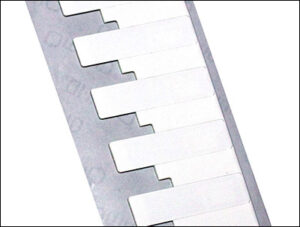
Sense IQ175
The five new tags measure temperatures, moisture levels or liquid volumes, and all incorporate Axzon‘s Magnus M3D chip to meet a broad range of industrial, IT and healthcare requirements. One of the products is the Sense Fit 500, a small ceramic tag for temperature and moisture sensing with a read range of up to 5 meters (16.4 feet), the company reports. Another, the Sense IQ 550P, is a printable off-metal label that provides temperature, moisture and liquid fill-level data, with a range up to 5.8 meters (19 feet).
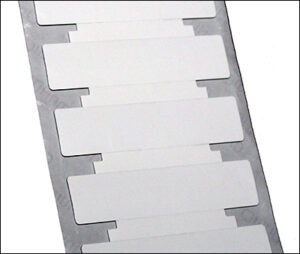
Sense IQ430
The third product is the Sense IQ 175, which offers U.S. and E.U. frequency compatibility. This tag is printable on metal, with temperature and moisture sensing, and has a read range up to 1.75 meters (5.7 feet). The Sense IQ 430, also compatible with U.S. and E.U. frequencies, provides a longer read range at 4.3 meters (14.1 feet). Finally, the Sense IQ 200P is an off-metal circular product that senses temperature and moisture levels for non-metallic items and offers a read range up to 2 meters (6.6 feet).
The wireless battery-free tags can accurately measure temperatures to a tolerance of 0.5 degrees Celsius (32.9 degrees Fahrenheit) and offer read ranges between 1.75 and 5 meters (5.7 and 16.4 feet), which Omni-ID says makes them suitable for use in hazardous industrial environments, in which thermocouples would traditionally monitor asset temperatures. The passive tags are designed for monitoring the conditions of assets where space is limited, or where high volumes of tags are needed, making active solutions too expensive.
HID Global acquired Omni-ID in August 2021 (see Acquisition of Omni-ID Expands HID’s Geographic RFID and IoT Presence), and that has helped the company grow its offerings, which currently span frequencies from 125 kHz (LF) to 13.56 MHZ (NFC), as well as HF RFID, UHF, BLE and LoRaWAN technologies. However, Kington says, its primary core business remains passive UHF RFID. Omni-ID’s active Sense tags are being rolled out for such use cases as tracking equipment for construction companies. The firm decided in February 2020 to develop the passive products with the goal of complementing its active solutions, and they are being rolled out now.
Broadening Wireless Sensing Options
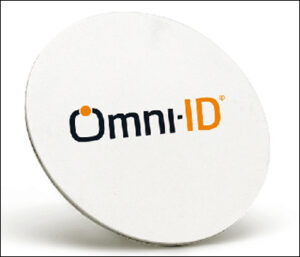
Sense IQ2000
“We are in the process of aligning the two product portfolios [active and passive],” Kington says, in order to provide solutions across a wide set of applications. Each technology offers benefits and challenges, he notes, though active solutions come at a cost. BLE beacons can be priced at $25 or more apiece, but they provide a relatively long read range in real time. That makes them optimal when tags are not needed in large quantities, he says. “I think if you look at what the active products give you, they offer the ability to log data and transmit a tremendous amount of data points, but that does come with a cost.”
One example is tracking conditions in restaurant chains to manage appliance conditions, such as refrigerator temperatures. The tags are also being used to monitor the conditions of industrial machinery. What the passive versions of the Sense family offer, Kington explains, is a “relatively low-cost point of [as little as] a dollar and the ability to tag many more assets.” Pilots and evaluations are already ongoing, he adds, and applications have been wide and varied.
One potential user is a manufacturer of electric car battery modules. Such batteries operate at peak efficiency when the temperature is maintained between 15 and 20 degrees Celsius (59 and 68 degrees Fahrenheit), so they come equipped with heating and cooling systems. The companies making these units can employ the passive Sense tags to detect any leaks, as well as temperatures, in order to ensure the systems are working prior to the module being shipped.
New Tags Provide Low Cost and Durability

Tony Kington
Additionally, Kington says, the passive tag offers greater durability for some industrial settings. “A passive tag is a lot lighter and smaller,” he explains, “and has a much better chance of standing up to stresses and strains.” A utility company could, for instance, apply a passive Sense tag to a moving part, such as a spinning turbine, to track conditions without concern for damaging the tags during the industrial operations.
With regard to the cannabidiol sector, sensors could be placed in the soil around each plant’s roots, which could check moisture and ambient temperature levels to ensure healthy conditions prior to harvesting. Omni-ID is also working with a pharmaceutical company to test whether the tags could track conditions to which high-value medical samples are exposed. The tags could track temperatures as cultures traveled to a laboratory, then when they were stored, tested or delivered to patients. Other applications will be deployed in the coming months as well, Kington says.
“We have been initiative-rich over the last year or two,” Kington states. “I think the next nine months are really about executing on the opportunities we’ve developed.” He envisions two common models for collecting data from the new Sense tags. In one scenario, users would carry a handheld reader to interrogate the tags on a periodic basis. The other model, requiring a costlier infrastructure investment, would employ a fixed network of readers that could collect data every hour (or at another pre-set frequency) to automate sensor data collection and management.
Key Takeaways:
- Omni-ID’s passive RFID tags now come with sensor functionality at a relatively low cost, via Axzon’s Magnus M3D
- The five new products join a family of sensing tags that include BLE and LoRaWAN for applications dedicated to distance reading in real time.
Exhibitors at RFID Journal LIVE! 2022 will offer passive RFID sensing solutions for cold supply chain monitoring, data centers, construction and other use cases. To learn more, visit the event’s website.

